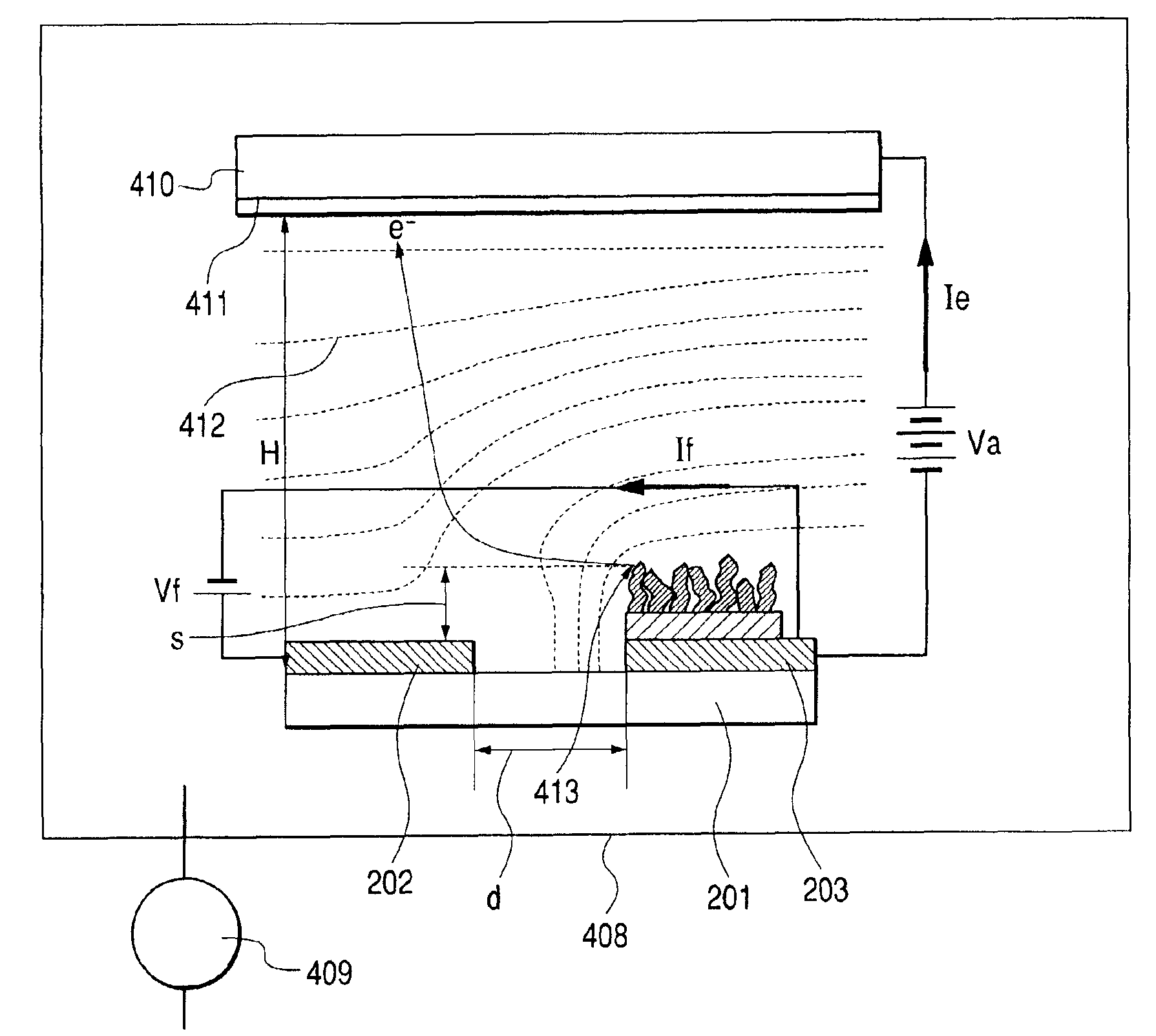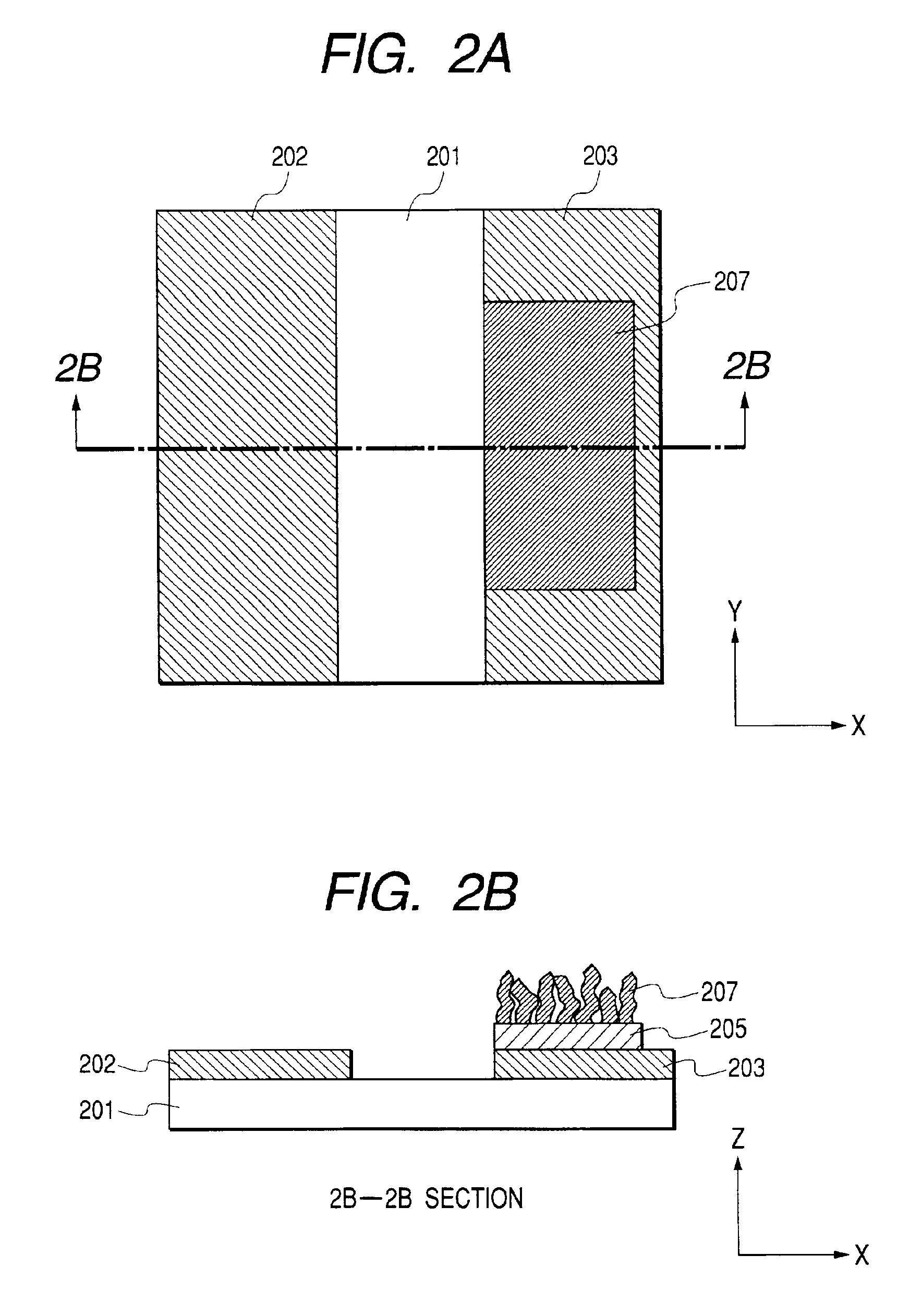Catalyst used to form carbon fiber, method of making the same and electron emitting device, electron source, image forming apparatus, secondary battery and body for storing hydrogen
- Summary
- Abstract
- Description
- Claims
- Application Information
AI Technical Summary
Benefits of technology
Problems solved by technology
Method used
Image
Examples
example 1
[0140]In the first Example, Pd and Co are added as catalyzing particles by the common sputtering manner.
[0141]Now, a method of making electron emitting device of the present example is described in detail with reference to FIGS. 1A to 1E.
(Step 1)
[0142]After cleaning the substrate 101 sufficiently with the quartz substrate, Ti with thickness of 5 nm and Pt with thickness of 100 nm, not shown, are continuously evaporated on overall substrate by sputtering at an initial stage in order to form the gate electrode 102 and the cathode (emitter) electrode 103.
[0143]Then, the resist pattern is formed using a not-shown positive type photoresist in the photolithography process.
[0144]Then, the patterned photoresist as mask is dry-etched by using Ar gas on the Pt layer and Ti layer, and the gate electrode 102 and the cathode 103 having an electrode gap (width of interval) of 5 μm is patterned (FIG. 1A).
(Step 2)
[0145]The resist pattern 104 is formed using negative type photoresist used for afterw...
example 2
[0152]In the second embodiment, Pd and Fe are added as catalytic particles by common co-evaporation method.
[0153]In the present embodiment, after making the electron emitting device in a similar manner to the first embodiment, except that the second process is conducted as below, If and Ie are measured.
(Step 2)
[0154]The resist pattern 104 is formed using negative type photoresist used for lift-off of an upper layer in the photolithography process (FIG. 1B).
[0155]Then, TiN layer is formed as a conductive material layer 105 on which the carbon fiber 107 would be grown with the medium of the catalytic particles 106.
[0156]And, the catalytic particles 106 of the present invention are formed by a common electron beam (two materials simultaneously) evaporation manner as follows. Then, the catalytic particles are deposited on TiN layer by using Pd and Fe as vacuum evaporation sources. As a result, the catalytic particles 106 containing Fe component of 20 atm % to Pd is formed in an island s...
example 3
[0158]In the third embodiment, Pd and Ni are added as catalytic particles by liquid coating.
[0159]In the present embodiment, after making the electron emitting element in a similar manner to the first embodiment, except that the second process is conducted as below, If and Ie are measured.
(Step 2)
[0160]The resist pattern 104 is formed using negative type photoresist used for lift-off of an upper layer in the photolithography process (FIG. 1B).
[0161]Then, TiN layer is formed as a conductive material layer 105 on which the carbon fiber 107 would be grown with the medium of the catalytic particles 106.
[0162]And, the catalytic particles 106 of the present invention are formed by liquid coating as follows. By using mixed solution of acetic acid complex of Pd and Ni, the mixed liquid is spinner-coated. After coating, it is heated at the atmosphere. As a result, the catalytic particles 106 containing Ni component of 25 atm % to Pd is formed in an island shape (FIG. 1C).
[0163]If and Ie char...
PUM
| Property | Measurement | Unit |
|---|---|---|
| Diameter | aaaaa | aaaaa |
| Diameter | aaaaa | aaaaa |
| Fraction | aaaaa | aaaaa |
Abstract
Description
Claims
Application Information
 Login to View More
Login to View More - R&D
- Intellectual Property
- Life Sciences
- Materials
- Tech Scout
- Unparalleled Data Quality
- Higher Quality Content
- 60% Fewer Hallucinations
Browse by: Latest US Patents, China's latest patents, Technical Efficacy Thesaurus, Application Domain, Technology Topic, Popular Technical Reports.
© 2025 PatSnap. All rights reserved.Legal|Privacy policy|Modern Slavery Act Transparency Statement|Sitemap|About US| Contact US: help@patsnap.com



